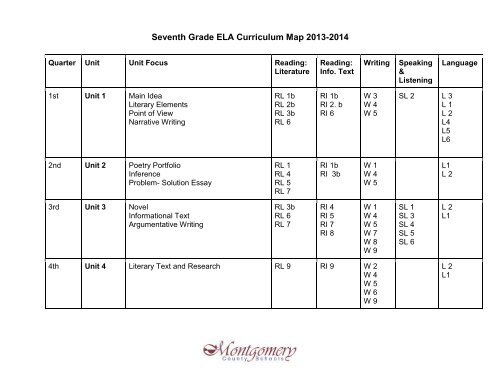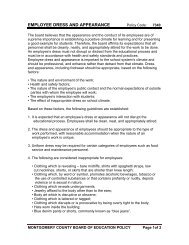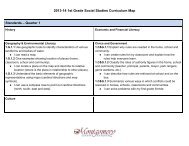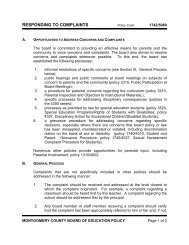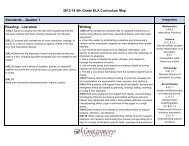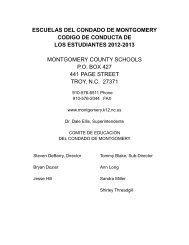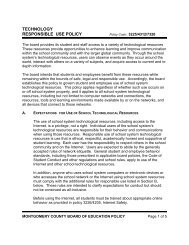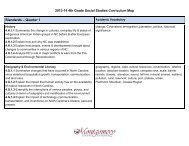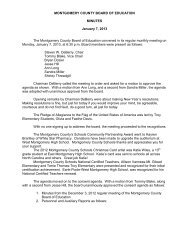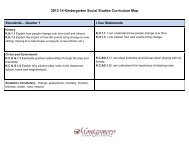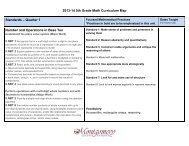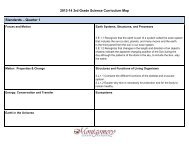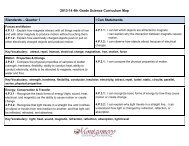7th ELA Curriculum Map.docx
7th ELA Curriculum Map.docx
7th ELA Curriculum Map.docx
You also want an ePaper? Increase the reach of your titles
YUMPU automatically turns print PDFs into web optimized ePapers that Google loves.
Seventh Grade <strong>ELA</strong> <strong>Curriculum</strong> <strong>Map</strong> 2013-2014RL 6. Analyze how an author develops and contrasts thepoints of view of different characters or narrators in a text.RI 6. Determine an author’s point of view or purpose in a textand analyze how the author distinguishes his or her positionfrom that of others.W 3. Write narratives to develop real or imaginedexperiences or events using effective technique, relevantdescriptive details, and well-structured event sequences.a. Engage and orient the reader by establishing acontext and point of view and introducing a narrator and/orcharacters; organize an event sequence that unfoldsnaturally and logically.b. Use narrative techniques, such as dialogue,pacing, and description, to develop experiences, events,and/or characters.c. Use a variety of transition words, phrases, andclauses to convey sequence and signal shifts from one timeframe or setting to another.d. Use precise words and phrases, relevantdescriptive details, and sensory language to capture theaction and convey experiences and events.e. Provide a conclusion that follows from and reflectson the narrated experiences or events.W 4. Produce clear and coherent writing in which thedevelopment, organization, and style are appropriate to task,purpose, and audience.I can analyze how an author develops the differencesand points of view of different characters in text.I can identify the author’s point of view, and how it isdifferent from other’s positions.I can write a narrative essay.I can write in a clear and precise format.
Seventh Grade <strong>ELA</strong> <strong>Curriculum</strong> <strong>Map</strong> 2013-2014L 6. Acquire and use accurately a range of generalacademic and domain-specific words and phrasessufficient for reading, writing, speaking, and listening at thecollege and career readiness level; demonstrateindependence in gathering vocabulary knowledge whenencountering an unknown term important to comprehensionor expression.I can build upon my academic/grade level vocabularythroughout the year.Vocab Unit 1Etymology Syntax Genres (Examples)DerivationTransition WordsUnit 1 Writing - Narrative Writing- For Classroom UsePersonal- Think of something that you really wanted to accomplish and how you achieved the goal.Fantasy- You find a genie that grants only one wish. You may wish for whatever you would like but your wish mustchange the world.
Unit: 2Seventh Grade <strong>ELA</strong> <strong>Curriculum</strong> <strong>Map</strong> 2013-2014Quarter: 2ndStandardLearning TargetRL 4. Determine the meaning of words and phrases as theyare used in a text, including figurative and connotativemeanings; analyze the impact of rhymes and other repetitionsof sounds (e.g., alliteration) on a specific verse or stanza of apoem or section of a story or drama.RL 5. Analyze how a drama or poem’s form or structure (e.g.,soliloquy, sonnet) contributes to its meaning.I can determine the meaning of words and phrases asthey are used in text and analyze the impact of literarydevices found in a variety of texts.I can analyze how the structure of drama’s and poemcontributes to its meaning.RL 7. Compare and contrast a written story, drama, or poemto its audio, filmed, staged, or multimedia version, analyzingthe effects of techniques unique to each medium (e.g.,lighting, sound, color, or camera focus and angles in a film).RL 1. b Cite several pieces of textual evidence to supportanalysis of what the text says explicitly as well as inferencesdrawn from the text.RI 1. b Cite several pieces of textual evidence to supportanalysis of what the text says explicitly as well as inferencesdrawn from the text.RI 3. b Analyze the interactions between individuals, events,and ideas in a text (e.g., how ideas influence individuals orevents, or how individuals influence ideas or events).I can compare and contrast texts that I’ve read to onesthat I watch, listen to, or see presented in othermultimedia formats.I can make inferences and find textual evidence forsupporting my analysis.I can make inferences and find textual evidence forsupporting my analysis.I can analyze the interactions between individuals,events and ideas in a text.
Seventh Grade <strong>ELA</strong> <strong>Curriculum</strong> <strong>Map</strong> 2013-2014W 1. Write arguments to support claims with clear reasonsand relevant evidence.a. Introduce claim(s), acknowledge alternate oropposing claims, and organize the reasons and evidencelogically.b. Support claim(s) with logical reasoning and relevantevidence, using accurate, credible sources anddemonstrating an understanding of the topic or text.c. Use words, phrases, and clauses to create cohesionand clarify the relationships among claim(s), reasons, andevidence.d. Establish and maintain a formal style.e. Provide a concluding statement or section thatfollows from and supports the argument presented.W 4. Produce clear and coherent writing in which thedevelopment, organization, and style are appropriate to task,purpose, and audience.W 5. With some guidance and support from peers and adults,develop and strengthen writing as needed by planning,revising, editing, rewriting, or trying a new approach, focusingon how well purpose and audience have been addressed.L 1. Demonstrate command of the conventions of StandardEnglish grammar and usage when writing or speaking.I can write an argumentative essay.I can write in a clear and precise format.I can improve my writing by following the writingprocess.I can demonstrate command of the conventions ofstandard English grammar and usage in my writing andspeaking by using phrases and clauses to create morecomplex sentences structures.
Seventh Grade <strong>ELA</strong> <strong>Curriculum</strong> <strong>Map</strong> 2013-2014Vocab Unit 2Subliminal Rhythm FigurativeJargon Oxymoron ConnotativeWriting Unit 2- Argumentative - For Classroom UseShould students be allowed to bring electronics into the classroom? Why or Why not?
Unit: 3Seventh Grade <strong>ELA</strong> <strong>Curriculum</strong> <strong>Map</strong> 2013-2014Quarter: 3rdStandardLearning TargetRL 3. b Analyze how particular elements of a story or dramainteract (e.g., how setting shapes the characters or plot).RL 6. Analyze how an author develops and contrasts thepoints of view of different characters or narrators in a text.RL 7. Compare and contrast a written story, drama, orpoem to its audio, filmed, staged, or multimedia version,analyzing the effects of techniques unique to each medium(e.g., lighting, sound, color, or camera focus and angles in afilm).RI 4. Determine the meaning of words and phrases as theyare used in a text, including figurative, connotative, andtechnical meanings; analyze the impact of a specific wordchoice on meaning and tone.RI 5. Analyze the structure an author uses to organize atext, including how the major sections contribute to thewhole and to the development of the ideas.RI 7. Compare and contrast a text to an audio, video, ormultimedia version of the text, analyzing each medium’sportrayal of the subject (e.g., how the delivery of a speechaffects the impact of the words).RI 8. Trace and evaluate the argument and specific claimsI can analyze how elements of fiction or drama, interact.I can analyze how an author develops the differences andpoints of view of different characters in text.I can compare and contrast texts that I’ve read to onesthat I watch, listen to, or see presented in othermultimedia formats.I can determine the meaning of words and phrases asthey are used in text.I can analyze the structure and author uses to organize atext.I can compare and contrast texts that I’ve read to onesthat I watch, listen to, or see presented in othermultimedia formats.I can trace and evaluate the argument and claims made in
Seventh Grade <strong>ELA</strong> <strong>Curriculum</strong> <strong>Map</strong> 2013-2014in a text, assessing whether the reasoning is sound and theevidence is relevant and sufficient to support the claims.SL 1. Engage effectively in a range of collaborativediscussions (one-on-one, in groups, and teacher-led) withdiverse partners on grade 7 topics, texts, and issues,building on others’ ideas and expressing their own clearly.a. Come to discussions prepared, having read orresearched material under study; explicitly draw on thatpreparation by referring to evidence on the topic, text, orissue to probe and reflect on ideas under discussion.b. Follow rules for collegial discussions, trackprogress toward specific goals and deadlines, and defineindividual roles as needed.c. Pose questions that elicit elaboration and respondto others’ questions and comments with relevantobservations and ideas that bring the discussion back ontopic as needed.d. Acknowledge new information expressed byothers and, when warranted, modify their own views.W 1. Write arguments to support claims with clear reasonsand relevant evidence.a. Introduce claim(s), acknowledge alternate oropposing claims, and organize the reasons and evidencelogically.b. Support claim(s) with logical reasoning andrelevant evidence, using accurate, credible sources anddemonstrating an understanding of the topic or text.a variety of texts.I can engage in a variety of collaborative discussions on7 th grade topics, texts and issues.I can write an argumentative essay.
c. Use words, phrases, and clauses to createcohesion and clarify the relationships among claim(s),reasons, and evidence.d. Establish and maintain a formal style.e. Provide a concluding statement or section thatfollows from and supports the argument presented.Seventh Grade <strong>ELA</strong> <strong>Curriculum</strong> <strong>Map</strong> 2013-2014W 4. Produce clear and coherent writing in which thedevelopment, organization, and style are appropriate totask, purpose, and audience.W 5. With some guidance and support from peers andadults, develop and strengthen writing as needed byplanning, revising, editing, rewriting, or trying a newapproach, focusing on how well purpose and audience havebeen addressed. (Editing for conventions shoulddemonstrate command of standards L 1–3)W 7. Conduct short research projects to answer a question,drawing on several sources and generating additionalrelated, focused questions for further research andinvestigation.W 8. Gather relevant information from multiple print anddigital sources, using search terms effectively; assess thecredibility and accuracy of each source; and quote orparaphrase the data and conclusions of others whileavoiding plagiarism and following a standard format forcitation.I can write in a clear and precise format.I can improve my writing by following the writing process.I can conduct short research projects, using a variety ofsources.I can conduct research and give proper credit to a varietyof sources.
Seventh Grade <strong>ELA</strong> <strong>Curriculum</strong> <strong>Map</strong> 2013-2014W 9. Draw evidence from literary or informational texts tosupport analysis, reflection, and research.b. Apply grade 7 Reading standards to literarynonfiction (e.g., “Trace and evaluate the argument andspecific claims in a text, assessing whether the reasoning issound and the evidence is relevant and sufficient to supportthe claims”).SL 3. Delineate a speaker’s argument and specific claims,evaluating the soundness of the reasoning and therelevance and sufficiency of the evidence.SL 4. Present claims and findings, emphasizing salientpoints in a focused, coherent manner with pertinentdescriptions, facts, details, and examples; use appropriateeye contact, adequate volume, and clear pronunciation.SL 5. Include multimedia components and visual displays inpresentations to clarify claims and findings and emphasizesalient points.SL 6. Adapt speech to a variety of contexts and tasks,demonstrating command of formal English when indicatedor appropriate.I can use evidence from literary and informational texts tosupport my analysis, reflections and research.I can evaluate a speaker’s argument.I can present claims and findings using appropriate eyecontact, adequate volume, and clear pronunciation.I can include multimedia components and visual displaysin presentations I make.I can adapt my speech to a variety of contexts and tasks,demonstrating command of formal English whenappropriate.L 1. Demonstrate command of the conventions of StandardEnglish grammar and usage when writing or speaking.I can demonstrate command of the conventions ofstandard English grammar and usage in my writing andspeaking by using phrases and clauses to create morecomplex sentences structures.
Seventh Grade <strong>ELA</strong> <strong>Curriculum</strong> <strong>Map</strong> 2013-2014L2. Demonstrate command of the conventions of StandardEnglish capitalization, punctuation, and spelling whenwriting.I can demonstrate command of the conventions ofstandard English capitalization, punctuation and spellingin my writing.Vocab for Unit 3Criticism Protagonist Comedy Situational IronyMonologue Antagonist Verbal Irony Dramatic IronyWriting Unit 3- Argumentative - For Classroom UseAre zoos good or bad places? Research and provide evidence to support your claim.
Unit: 4StandardSeventh Grade <strong>ELA</strong> <strong>Curriculum</strong> <strong>Map</strong> 2013-2014Learning TargetQuarter: 4thRL 9. Compare and contrast a fictional portrayal of a time,place, or character and a historical account of the sameperiod as a means of understanding how authors of fictionuse or alter history.RI 9. Analyze how two or more authors writing about thesame topic shape their presentations of key information byemphasizing different evidence or advancing differentinterpretations of facts.W 2. Write informative/explanatory texts to examine a topicand convey ideas, concepts, and information through theselection, organization, and analysis of relevant content.a. Introduce a topic clearly, previewing what is tofollow; organize ideas, concepts, and information, usingstrategies such as definition, classification,comparison/contrast, and cause/effect; include formatting(e.g., headings), graphics (e.g., charts, tables), andmultimedia when useful to aiding comprehension.b. Develop the topic with relevant facts, definitions,concrete details, quotations, or other information andexamples.c. Use appropriate transitions to create cohesion andclarify the relationships among ideas and concepts.d. Use precise language and domain-specificvocabulary to inform about or explain the topic.I can compare and contrast historical fiction elements toactual events in history.I can analyze how different authors present their ownevidence for different interpretations of the same topic.I can write and informative/explanatory essay.
e. Establish and maintain a formal style.f. Provide a concluding statement or section thatfollows from and supports the information or explanationpresented.Seventh Grade <strong>ELA</strong> <strong>Curriculum</strong> <strong>Map</strong> 2013-2014W 4. Produce clear and coherent writing in which thedevelopment, organization, and style are appropriate totask, purpose, and audience.W 5. With some guidance and support from peers andadults, develop and strengthen writing as needed byplanning, revising, editing, rewriting, or trying a newapproach, focusing on how well purpose and audience havebeen addressed. (Editing for conventions shoulddemonstrate command of standards L 1–3)W 6. Use technology, including the Internet, to produce andpublish writing and link to and cite sources as well as tointeract and collaborate with others, including linking to andciting sources.W 9. Draw evidence from literary or informational texts tosupport analysis, reflection, and research.a. Apply grade 7 Reading standards to literature(e.g., “Compare and contrast a fictional portrayal of a time,place, or character and a historical account of the sameperiod as a means of understanding how authors of fictionuse or alter history”).L 1. Demonstrate command of the conventions of StandardI can write in a clear and precise format.I can improve my writing by following the writing process.I can use technology to produce and publish what I write.I can use evidence from literary and informational texts tosupport my analysis, reflections and research.I can demonstrate command of the conventions of
Seventh Grade <strong>ELA</strong> <strong>Curriculum</strong> <strong>Map</strong> 2013-2014English grammar and usage when writing or speaking.standard English grammar and usage in my writing andspeaking by using phrases and clauses to create morecomplex sentences structures.L 2. Demonstrate command of the conventions of StandardEnglish capitalization, punctuation, and spellingwhen writing.I can demonstrate command of the conventions ofstandard English capitalization, punctuation and spellingin my writing.Vocab for Unit 4PlagiarismDocumentaryCite/ CitedMultimediaWriting Unit 4- Research - For Classroom UseResearch the requirements needed for your favorite career. Job Description, Job Requirements, Salary (Beginning andMax), Education (Training locations, Colleges, Professional Development, etc.), and Job Availability (Amount of Jobs,Job Locations) should be included in your research. Cite all sources used.


